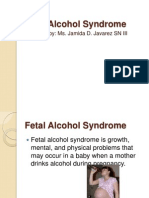0 ratings0% found this document useful (0 votes)
268 viewsAbortion: An Overview of The Ethical Issues
Abortion: An Overview of The Ethical Issues
Uploaded by
Lorena VukicThe document discusses the ethical issues surrounding abortion and outlines the key considerations on both sides of the debate, including the moral status of the fetus and the rights of the pregnant woman. It also examines criteria for personhood and provides an overview of common arguments made regarding abortion.
Copyright:
© All Rights Reserved
Available Formats
Download as PDF, TXT or read online from Scribd
Abortion: An Overview of The Ethical Issues
Abortion: An Overview of The Ethical Issues
Uploaded by
Lorena Vukic0 ratings0% found this document useful (0 votes)
268 views25 pagesThe document discusses the ethical issues surrounding abortion and outlines the key considerations on both sides of the debate, including the moral status of the fetus and the rights of the pregnant woman. It also examines criteria for personhood and provides an overview of common arguments made regarding abortion.
Original Description:
ethical issues about abortion
Original Title
Abortion
Copyright
© © All Rights Reserved
Available Formats
PDF, TXT or read online from Scribd
Share this document
Did you find this document useful?
Is this content inappropriate?
The document discusses the ethical issues surrounding abortion and outlines the key considerations on both sides of the debate, including the moral status of the fetus and the rights of the pregnant woman. It also examines criteria for personhood and provides an overview of common arguments made regarding abortion.
Copyright:
© All Rights Reserved
Available Formats
Download as PDF, TXT or read online from Scribd
Download as pdf or txt
0 ratings0% found this document useful (0 votes)
268 views25 pagesAbortion: An Overview of The Ethical Issues
Abortion: An Overview of The Ethical Issues
Uploaded by
Lorena VukicThe document discusses the ethical issues surrounding abortion and outlines the key considerations on both sides of the debate, including the moral status of the fetus and the rights of the pregnant woman. It also examines criteria for personhood and provides an overview of common arguments made regarding abortion.
Copyright:
© All Rights Reserved
Available Formats
Download as PDF, TXT or read online from Scribd
Download as pdf or txt
You are on page 1of 25
Abortion:
An Overview of the Ethical Issues
Lawrence M. Hinman, Ph.D.
Professor of Philosophy
University of San Diego
Larry at EthicsMatters dot net
February 27, 2013
2/27/13 (c) Lawrence M. Hinman 1
Introduction
Abortion is the most difficult and controversial
moral issues we will consider.
Listen to both sides, even if that is difficult to do.
Both sides have important moral insights,
even if ultimately these insights are
outweighed by the insights of the other side.
The goal of this presentation is not to convince
you to accept one position or the other, but to
help you to understand both side.
2/27/13 (c) Lawrence M. Hinman 2
The Rhetoric of Abortion Discussions
Beware of the labels Pro-life and Pro-choice.
They imply that the other side is against life or against
choice.
They ignore the nuances in a persons position.
2/27/13 (c) Lawrence M. Hinman 3
The Empirical Picture
Two principal sources of data:
CDC abortion stats, 2005
Guttmacher stats, 2008
Data tend to be incomplete
Overall in US, number of abortions is decreasing.
2/27/13 (c) Lawrence M. Hinman 4
About 1.25 M in 2005
.
Pregnancy & Intentions
In the United States:
49% of pregnancies were unintended (2006)
Of unintended pregnancies, 49% ended in abortions
Unintended pregnancies increased among poor women,
decreased among financially well-off women.
Unintended pregnancies increased among black and
Hispanic women.
2/27/13 (c) Lawrence M. Hinman 5
Reasons given for abortions
2/27/13 (c) Lawrence M. Hinman 6
Concern for/responsibility to other individuals 74%
Cannot afford a baby now 73%
A baby would interfere with school/
employment/ability to care for dependents 69%
Would be a single parent/
having relationship problems 48%
Has completed childbearing 38%
Source: Finer et al., 2005 (2004 data)
Two Principal Moral Considerations
The moral status of the fetus
Is the fetus a person? At what stage in its development
does it becomes a person? Conception? 1
st
trimester?
Birth?
The rights of the pregnant woman
Does the pregnant woman have the right to decide if she
is going to carry the baby to term or not?
2/27/13 (c) Lawrence M. Hinman 7
An Important Distinction
As you consider this difficult issue, it is
important to distinguish two questions:
Is abortion morally wrong?
Should abortion be illegal?
These are distinct issues. Not everything that is
immoral is necessarily illegal. We may, for
example, want to say that being unfaithful in
ones marriage is immoral, but we may not
want to see it made illegal.
2/27/13 (c) Lawrence M. Hinman 8
The Central Argument
Here is the main argument that is usually advanced against
abortion:
P
1
: The fetus is an innocent person.
P
2
: It is morally wrong to end the life of an innocent
person.
C: Therefore, it is morally wrong to end the life of a
fetus.
2/27/13 (c) Lawrence M. Hinman 9
The Moral Status of the Fetus
Much of the debate in regard to abortion has
centered around the first premise, namely,
whether the fetus is a person or not.
If the fetus is a person, then it has the rights that
belong to persons, including the right to life.
The concept of personhood, in other words, is the
bridge that connects the fetus with the right to life.
2/27/13 (c) Lawrence M. Hinman 10
Fetus
Personhood
Rights
Criteria of Personhood
Star Trek thought experiment
Possible criteria
Conceived by humans
Genetic structure
Physical resemblance
Presence of a soul
Viability
A future like ours
2/27/13 (c) Lawrence M. Hinman 11
Necessary and Sufficient Conditions
A necessary condition is something which
must be present for another thing to be
possible--e.g., having your eyes open is a
necessary condition for watching television.
A sufficient condition is something which, if
present, guarantees that the other thing will
occur--e.g., drinking a quart of whiskey is a
sufficient condition for becoming drunk.
2/27/13 (c) Lawrence M. Hinman 12
Necessary and Sufficient Conditions of
Personhood
Using this distinction, we can then ask:
What are the necessary conditions of personhood?
What are the sufficient conditions of personhood?
2/27/13 (c) Lawrence M. Hinman 13
The Relevance of Personhood
Some philosophers--beginning with
Judith Jarvis Thomson and Jane
English--have argued that, even if
the fetus is a person, abortion
may be morally justified. In other
words, they dispute the truth of
the premise, It is wrong to end
the life of an innocent person.
2/27/13 (c) Lawrence M. Hinman 14
The Violinist Example
Thomson offers an analogy: imagine that you
were knocked unconscious, hooked up to a
famous violinist who must depend on you for
life support for the coming nine months.
Thomson maintains that you would be morally
justified in unhooking yourself, even if it
resulted in the death of the violinist.
By analogy, a pregnant woman is justified in
unhooking herself from the fetus, even if
doing so results in the death of the fetus and
even if the fetus is a person.
2/27/13 (c) Lawrence M. Hinman 15
Limitations of the Violinist Analogy
Thomsons analogy has several limitations:
Only covers
cases of rape.
The violinist is
not someone
to whom one is
related, even
potentially.
2/27/13 (c) Lawrence M. Hinman 16
Jane Englishs Revisions
The philosopher Jane English amended Thomsons example.
Imagine that you go out at night, knowing that you might
be rendered unconscious and hooked up to the violinist.
You would still, according to English, be entitled to unhook
yourself.
This case is more closely analogous to conventional cases
of unwanted pregnancies.
2/27/13 (c) Lawrence M. Hinman 17
The Rights of the Pregnant Woman
What right does a woman possess that would entitle her to
choose an abortion?
Right to privacy.
this is the right specified in Roe v. Wade.
Right to ownership of ones own body.
Is ownership a perspicuous category?
Right to equal treatment.
Men cant get pregnant.
Right to self-determination.
Women have the right to decide about their own futures.
It is morally repellent to force a woman to bear a child against her will.
2/27/13 (c) Lawrence M. Hinman 18
Feminist Concerns about Abortion
See abortion issue within context of
history of oppression of women
history of danger and death for women when abortion is
illegal
2/27/13 (c) Lawrence M. Hinman 19
Abortion and Racism
Some, particularly within African-American communities, see
the call for abortion as a racist, genocidal threat.
2/27/13 (c) Lawrence M. Hinman 20
Rights of the Father
To what extent do the fathers preferences count in
making this decision?
Mother actually give birth, fathers dont.
Society usually places primary responsibility on the
mother.
Fathers dont even always know they are fathers;
mothers always do.
2/27/13 (c) Lawrence M. Hinman 21
Principle of the Double Effect
Four conditions must be met:
1. the action itself must be either morally good or at
least morally neutral;
2. the bad consequences must not be intended;
3. the good consequences cannot be the direct causal
result of the bad consequences; and
4. the good consequences must be proportionate to
the bad consequences.
2/27/13 (c) Lawrence M. Hinman 22
Abortion and Sex Selection
Some worry that abortion, coupled with techniques for
determining whether the fetus is male or female, could be
used for sex selection, which would probably result in
fewer female babies.
2/27/13 (c) Lawrence M. Hinman 23
Seeking a Common Ground
Points of possible agreement
Reducing unwanted pregnancies
- But: disagreement about the means
Guaranteeing genuinely free and informed choice
Providing a loving home for all children
2/27/13 (c) Lawrence M. Hinman 24
Notable Web Resources
Ethics Updates
Steven Schwartz, The Moral Question of Abortion.
(Loyola University Press, 1990). Full text of entire book.
Judith Jarvis Thomson, "Abortion," The Boston Review,
Vol. XX, No. 3, (Jan 1994/Dec 1995). Full text & replies.
George McKenna, "On Abortion: A Lincolnian Position,"
The Atlantic Monthly, Vol. 276, No. 3; (September, 1995).
Martha Bayles, "Feminism and Abortion." Atlantic
Monthly. April, 1990.
2/27/13 (c) Lawrence M. Hinman 25
You might also like
- Segmconference2023 10-3-23 Ip-SpeakersDocument9 pagesSegmconference2023 10-3-23 Ip-Speakersapi-698589423No ratings yet
- Single Subject DesignDocument15 pagesSingle Subject Designmartin kogoNo ratings yet
- Abortion Should Be LegalDocument3 pagesAbortion Should Be LegalPAUL MUGUNANo ratings yet
- Domestic Violence - Focus Groups From The Survivors' PerspectiveDocument9 pagesDomestic Violence - Focus Groups From The Survivors' PerspectiveAma DelibNo ratings yet
- Euthanasia CloningDocument28 pagesEuthanasia CloningDavid RefuncionNo ratings yet
- Ethics of AbortionDocument10 pagesEthics of AbortionMohasin Niloy Ahmed 2121497642No ratings yet
- Homelessness in America - Problem-Solution MLA Citation PaperDocument7 pagesHomelessness in America - Problem-Solution MLA Citation PaperCoby PattersonNo ratings yet
- What Are The Main Causes and Effects of Classism Draft 5Document13 pagesWhat Are The Main Causes and Effects of Classism Draft 5api-266441484100% (1)
- Racial Discrimination EssayDocument6 pagesRacial Discrimination Essayapi-595421813No ratings yet
- Effects of Having Homophobic ParentsDocument6 pagesEffects of Having Homophobic ParentsKian Joshua FresnidoNo ratings yet
- Elizabeth Cady StantonDocument6 pagesElizabeth Cady Stantonemmi428No ratings yet
- The Counterculture MovementDocument4 pagesThe Counterculture MovementBerenice BaezNo ratings yet
- 5-Challenges of University Adjustment in The UK A Study of East Asian Master S Degree StudentsDocument17 pages5-Challenges of University Adjustment in The UK A Study of East Asian Master S Degree Students林磊No ratings yet
- Child AbuseDocument22 pagesChild AbuseSharon Umblas RubinoNo ratings yet
- Sources For Forced Sterilization and Eugenics Program NHD NationalsDocument27 pagesSources For Forced Sterilization and Eugenics Program NHD Nationalsapi-453652237No ratings yet
- Police BrutalityDocument13 pagesPolice Brutalityapi-466414033No ratings yet
- Child AbuseDocument24 pagesChild Abuseapi-357231993No ratings yet
- Argumentative Research PaperDocument15 pagesArgumentative Research Paperapi-357615638No ratings yet
- Teen Pregnancy DecisionDocument9 pagesTeen Pregnancy DecisionBizuayehu WoldeyesNo ratings yet
- Victor Cline's Study PDFDocument22 pagesVictor Cline's Study PDFsolay12No ratings yet
- Team B Final Case AnalysisDocument7 pagesTeam B Final Case Analysisrene_smithNo ratings yet
- La Leche LeagueDocument5 pagesLa Leche Leagueapi-302732994No ratings yet
- PsychologyDocument14 pagesPsychologyRana QaiserNo ratings yet
- Fetal Alcohol SyndromeDocument17 pagesFetal Alcohol SyndromeDiana Laura LeiNo ratings yet
- Universal Preschool Is No Golden Ticket: Why Government Should Not Enter The Preschool Business, Cato Policy Analysis No. 333Document31 pagesUniversal Preschool Is No Golden Ticket: Why Government Should Not Enter The Preschool Business, Cato Policy Analysis No. 333Cato InstituteNo ratings yet
- Final Irr Ap Seminar - Political and Historical of School ShootingsDocument8 pagesFinal Irr Ap Seminar - Political and Historical of School Shootingsapi-610394461100% (1)
- Children Mindset Amid LockdownDocument1 pageChildren Mindset Amid LockdownSulagna DeyNo ratings yet
- Views and Opinions About LGBTQDocument4 pagesViews and Opinions About LGBTQNokie TunayNo ratings yet
- Civil War EssayDocument3 pagesCivil War Essaykfranceschi1No ratings yet
- Affordable Care Act Policy BriefDocument8 pagesAffordable Care Act Policy BriefJimmy MundellNo ratings yet
- Research PaperDocument12 pagesResearch Paperapi-451581488No ratings yet
- Blumberg (1974) - Psychopathology of The Abusing Parent.: Volume 2-Part II & IIIDocument10 pagesBlumberg (1974) - Psychopathology of The Abusing Parent.: Volume 2-Part II & IIIMatt DarcyNo ratings yet
- N512 Assignment 1 Wanda MossDocument7 pagesN512 Assignment 1 Wanda MossWanda MossNo ratings yet
- LGBTDocument21 pagesLGBTLuna EANo ratings yet
- Facilitator Guide A Class DividedDocument8 pagesFacilitator Guide A Class Dividedbmorris777No ratings yet
- Hps 439a Final Paper 1Document9 pagesHps 439a Final Paper 1api-280707253No ratings yet
- Vaccine Induced Autism by Rick RollensDocument3 pagesVaccine Induced Autism by Rick Rollensjegjr7No ratings yet
- Paper FinalDocument21 pagesPaper Finalapi-316872041No ratings yet
- Protection of Pupil Rights Amendment (PPRA) Guidance For SchoolsDocument5 pagesProtection of Pupil Rights Amendment (PPRA) Guidance For SchoolsReclaim Oklahoma Parent EmpowermentNo ratings yet
- What Is Family?: Prepared By: Mr. Reyogie AntonioDocument7 pagesWhat Is Family?: Prepared By: Mr. Reyogie AntonioYogi AntonioNo ratings yet
- Senior Project - Research Paper FinalDocument23 pagesSenior Project - Research Paper Finalapi-348553585No ratings yet
- Directed Investigation Letter 9.10.21 - FLDocument4 pagesDirected Investigation Letter 9.10.21 - FLABC Action NewsNo ratings yet
- Research Paper About The Negative Effects On Children by Watching TV Written by Adriana Alexandra RojasDocument12 pagesResearch Paper About The Negative Effects On Children by Watching TV Written by Adriana Alexandra RojasAlexandra Cantillo50% (2)
- Cause and Effect in Childhood ObesityDocument17 pagesCause and Effect in Childhood ObesitySharon V.No ratings yet
- Breaking The Silence LGBTQ Students FinalDocument7 pagesBreaking The Silence LGBTQ Students Finalapi-286434558No ratings yet
- What Is Child Abuse and Neglect?Document8 pagesWhat Is Child Abuse and Neglect?Astari ArfianaNo ratings yet
- UN Homophobic BullyingDocument60 pagesUN Homophobic BullyingJohnNo ratings yet
- Applied Ethics Abortion: 1. Abortion Is An "Act Which A Woman Performs in Voluntarily Terminating, orDocument8 pagesApplied Ethics Abortion: 1. Abortion Is An "Act Which A Woman Performs in Voluntarily Terminating, oryip90No ratings yet
- Elder Abuse Neglect ReportDocument31 pagesElder Abuse Neglect ReportPatricia MariaNo ratings yet
- Hatred in The HallwaysDocument310 pagesHatred in The HallwaysLee GaylordNo ratings yet
- Names Social BiologyDocument287 pagesNames Social Biologykathie-o-keefe-2911No ratings yet
- Research EssayDocument6 pagesResearch Essayapi-495345368No ratings yet
- An Assessment of The Prevalence of Elder Abuse and Neglect in Akwa Ibom State, NigeriaDocument7 pagesAn Assessment of The Prevalence of Elder Abuse and Neglect in Akwa Ibom State, NigeriaAlexander Decker100% (1)
- Shattered Families: Perilous Intersection of Immigration Policy and The Child Welfare SystemDocument65 pagesShattered Families: Perilous Intersection of Immigration Policy and The Child Welfare SystemPatricia DillonNo ratings yet
- The Mythical Norm: Diversity, Crime and Justice in Canada, Edited by Barbara Perry, Pp. 57-72. ©Document16 pagesThe Mythical Norm: Diversity, Crime and Justice in Canada, Edited by Barbara Perry, Pp. 57-72. ©alex davidNo ratings yet
- Skiba Knesting Zero Tolerance 2001Document27 pagesSkiba Knesting Zero Tolerance 2001AylinNo ratings yet
- The Birth of Head Start: Preschool Education Policies in the Kennedy and Johnson AdministrationsFrom EverandThe Birth of Head Start: Preschool Education Policies in the Kennedy and Johnson AdministrationsNo ratings yet
- Alarmed Problem – Pregnancy in The Teenage: A Serious Crime and TragedyFrom EverandAlarmed Problem – Pregnancy in The Teenage: A Serious Crime and TragedyNo ratings yet
- A Study of the Lack of Hiv/Aids Awareness Among African American Women: a Leadership Perspective: Awareness That All Cultures Should Know AboutFrom EverandA Study of the Lack of Hiv/Aids Awareness Among African American Women: a Leadership Perspective: Awareness That All Cultures Should Know AboutRating: 5 out of 5 stars5/5 (1)



























































